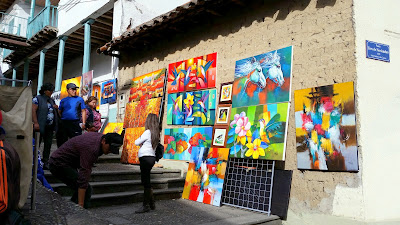Lima was established by Spanish conquistador, Francisco Pizarro in January of 1535.
Today the historic district of Lima is a UNESCO Heritage Site.
Below are photos of Plaza St. Martin, which is a large plaza surrounded by some of the most spectacular Spanish colonial architecture that can be found in South America. The buildings are impressive and speak to the grandeur of the importance of Lima as Spain's leading Vice-royalty while a colony of Spain. The park was constructed in 1921, which was the centenary celebration of Peru's independence. The name of the park and the monument in the center is in honor of General Jose de San Martin. The photos attempt to give you some idea of the panoramic effect of the buildings encompassing the park.
Most of these buildings were constructed in the early twentieth century.
As a result, the plaza maintains uniformity with respect to its
buildings' facades. Its overall appearance is primarily baroque; the
buildings, plaza, and central monument all cohere to uniform and
specific styles. The architectural style to which most of the
surrounding buildings outside of the Square of St. Martin's in Lima's historic district belong to is that of the neo-hispanic or
neo-colonial styles within the realm of European derived architecture, primarily of the Renaissance.
The photos below are of the Basilica del Cathedral de Lima. It is situated on Plaza Mayor and on Plaza de Armas; began construction in 1535; and it is dedicated to St. John, the Apostle and Evangelist.
The photo above is a painting of Francisco Pizarro landing in present day Lima. Pizarro's Tomb is in the basilica.
This is the main altar in the Basilica, which is flanked by fourteen side-altars.
Notice the semi-circular vaulted ceilings.
The nave of the Basilica del Cathedral de Lima. The wood carvings were done by wood craftsmen from Spain of realistic figures of the saints.
Unlike the Italian churches in which the ceilings are covered in frescoes. The ceiling in the Basilica would be quite plain and austere; if not for the interplay of the gold-painted wood strips, which give an elegance to the ceiling, and nicely complement the structure and the altar adorned in gold.
This facade with the beautiful wood-carved balconies is the Archbishop's Palace. Over 1,600 balconies exist in the historic center, and every effort is being made to preserve them. The opulence of the palace was not only unusual for the ecclesiastic hierarchy, but also for the top civil colonial administrators. The magnificence of many of the buildings were matched by the lavish interiors. Lima, the capital of the Vice-royalty of Peru was no colonial backwater, as were the colonial cities in North America during the 18th century.
The historical district of Lima with it many closely intertwined plazas, churches, courtyards, and public buildings designed in a colonial Renaissance style albeit with a Spanish twist; reminded me of Rome and Florence during my travels from earlier this year. The impact of the Italian renaissance upon Southern Europe in particular carried over to the Spanish colonies in a way that would not happen in British North America. Much of the building materials, slave labor, and wealth of the conquered Inca empire was also used to reconstruct new structures for the the Spaniards.
The San Francisco Basilica is next to the Basilica del Cathedral of Lima. San Francisco has underneath it layers of catacombs where a great deal of skulls and thousands of human skeletal remains are arranged in various geometric designs. The underground cemetery used during the colonial time is estimated to have 25,000 remains.
There are a large number of churches and ecclesiastical structures (monasteries, convents, hospitals) squeezed into this area. I am afraid after four months, I can no longer identify them all correctly. The photo above is the copula of Santa Domingo, the only authentic steeple in Lima.
The photo below is of decorative ceramic tiles from Seville.
A fresco below from a frieze in the courtyard of Santa Domingo.
The background image is of Santa Rosa of Lima. Lima's patron saint. Her feast day is one of the biggest celebrations of the year in Peru.
Statue of Santa Rosa of Lima
The courtyard of Santa Domingo reflects the Moorish (Islamic) influence; in particular, in its balcony of arches and pillars. The monastery also has a colonial library of over 25,000 manuscripts. Many of which are priceless.
Lima's Circuit Water Park Extravaganza
Created in 2007. The water park is spectacular. We had put off visiting until almost our last evening in Lima. Little did we know what a fabulous delight it was going to be. There are a total of thirteen fountains in a park setting. Easy to walk around, sit on benches, and enjoy. We spent about ninety minutes in the park. The evening is the time to go when the lights and fountains appear to interactively rise and fall and change to a multiplicity of colors.
The fountain (above and below) allows people to walk through its center. Another fountain can also be accessed, as mainly young people moved to the various center rings, and yes get wet as the sprays rise and ebb.
The Fountain of Fantasy presents a thirty minute synchronicity of lights, water elevations, and music with the addition of a colorful laser light program of projected images similar to holograms. The music and images are of nature, folk, classic, South American, the Beatles--a little of everything--in a fast pace program that is repeated every hour during the evening.
If you like archaeology, history, museums, the architecture of Lima's colonial center, gourmet dining in one of the world's top cuisine capitals, high-end shopping; a gambling casino on almost every block, and summer time enjoyment of the beaches and the Pacific; you just may enjoy a vacation in Lima.
*All photos courtesy of Nancy Thalmann
*All photos courtesy of Nancy Thalmann










































































































